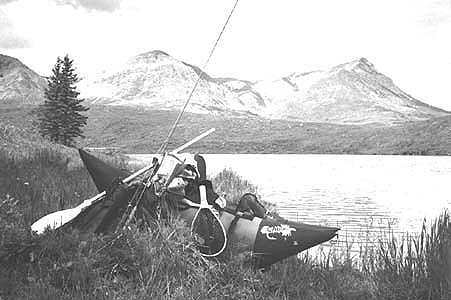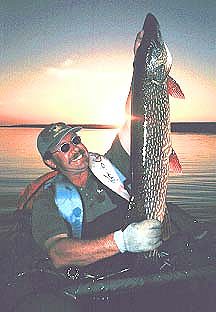Fly-Fishing in Lakes and Ponds
Adapted from "The Essential Guide to Fly-Fishing" by the author
By Clive Schaupmeyer
 Fly anglers across North America spend countless
hours fly-fishing in manmade ponds and natural
lakes for trout, pike, bass and panfish.
Fly anglers across North America spend countless
hours fly-fishing in manmade ponds and natural
lakes for trout, pike, bass and panfish.
The lakes and ponds you'll come across while chasing
fish vary as much or more than the fish and the techniques
used to catch them. There are warm southern, low-elevation
lakes that are teeming biological factories producing all kinds
of aquatic life including big trout, bass, or pike. In contrast,
high-altitude lakes in the western mountains of North America
are less productive. They may be 6, 8, or 10 thousand feet or
more in elevation. Depending on latitude and altitude they can
be cold and infertile, and the fish-growing season is short.
Most still waters where we fish are somewhere in between
these two extremes.

A few years ago the local irrigation district flooded a new
reservoir and it was stocked with hatchery trout. A few large rainbows got in from the Bow River that
fed the reservoir via a canal. The flooded prairie spiked the
reservoir water with nutrients and within two years there
were all sorts of rainbows over 10 pounds being caught.
The largest documented trout was over 19 pounds, and
I photographed my brother with a 13-pound rainbow. He
didn't catch it, but the opportunity to take a picture of
such a large rainbow couldn't be missed. This hog factory
slowed down after that, the trout were not replaced and it's
now emerging as a decent and stable walleye fishery.
According to Calgary-based fish biologist Jim Stelfox
some of the small high lakes in Alberta are so infertile
they have the capacity to produce only a few pounds
of fish per year in an entire lake. In 1994, I fished
6,000-foot Moat Lake in majestic Tonquin Valley in
Jasper National Park, Alberta. My wife, Willie, and I
were staying at a rustic lodge on Amethyst Lake we
had ridden to on horseback. A couple of other guests
and I decided to walk a mile over to Moat Lake to
fly-fish from shore.
There didn't seem to be a lot of fish on the lake,
but a bead-head nymph cast near the random sporadic
rises would usually result in a strike. These fish were
hungry and looking for food in the cold infertile water.
Their bodies were lean and their heads were slightly too
big for the rest of the fish, a sure sign there isn't much
to eat. To give you an idea of the short season, the ice
doesn't come off the lakes up there until June. And when
we rode out over a 7,000-foot pass there were 3 inches
of fresh snow under hoof. It was mid-August.

I've fly-fished in lakes that are over one hundred miles
long and in farm ponds you could cast across. I've
caught my share of 10-pound pike, many 10-inch trout
and smaller panfish in lakes. Sometimes the quarry has
been hatchery trout that were too stupid to know what
an insect is, yet would eat a pea-sized brown fly that
looked like a food pellet. Something not to be particularly
proud of, but you have to adjust technique to the situation.
A few years ago I landed and released two big brown trout
(19 and 21 inches) that lived in a beaver pond filled with
gin- clear water. There were only four browns in the entire
pond. Mind you the pond was smaller than a tennis court
and they were easy to see. It was an interesting lesson in
stealth. I dun good!
It would seem about the only thing these types of
fly-fishing have in common is the still water. But
surprisingly, they have a lot in common when it
comes to fly-fishing technique. I've caught rainbow,
brown, and brook trout, pike, bass, and panfish all
with a floating line, usually with one or two split shots
and some type of wet fly all stripped in with about
the same technique. Short four- to six- inch strips
about every second or two.
Sure other techniques may be required, but it amazes
me how little techniques vary in stillwaters. After all,
fish are fish, and water is water. About the only variables
you have to deal with are where the fish are, how deep
they are and what they are eating.
That sounds overly simple and it is. And of course it
still doesn't mean you'll catch fish. There are never
any guarantees.
Next week: Stillwater fishing and retrieval techniques.
Closing thought is from Robert Frost: "Two roads
diverged in a wood, and I took the one less traveled by.
And that made all the difference." ~ Clive Schaupmeyer
Our Man In Canada Archives
|

 December 7th, 1998
December 7th, 1998




 December 7th, 1998
December 7th, 1998



